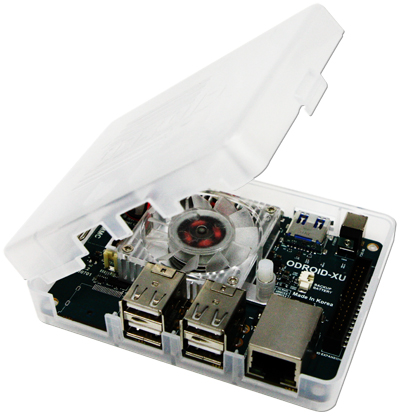ODROID-XU+E

ODROID-XU+E - Third Party Review
The first of its kind. A bare-board computer with a small architecture at its core. The ODROID-XU+E is equipped with a built-in power analysis utility. The ODROID-XU board has four current/voltage sensors to individually assess the electricity usage of the Big A15 cores, Little A7 cores, GPU, and DRAM components. This package comprises a customized version of the ODROID-XU board. The onboard power measuring circuit, which is incorporated, allows expert developers to monitor the power consumption of the CPU, GPU, and DRAM. When debugging for power usage, developers will save money and time by employing the inbuilt power analyzer tool. They will also have the opportunity to improve and optimize the performance of their CPU/GPU compute applications, thereby reducing power consumption to the lowest level possible.
The Exynos5 Octa has an eight-core ARM processor, a first in the industry. The big.LITTLE architecture is based on the Cortex-A15 CPU, designed to handle multitasking capabilities efficiently.
Samsung’s Exynos5 Octa mobile application processor is the world’s first to apply the revolutionary big.LITTLE idea of processing architecture is based on the Cortex-A15 CPU and designed to maximize the use of each core. It is made possible by the Exynos5 Octa’s eight cores, which include four powerful Cortex-A15 cores for intensive processing tasks and four Cortex-A7 quad cores for lighter workloads. The Exynos5 Octa allows mobile devices to achieve maximum performance by utilizing all eight cores (four strong Cortex-A15 cores for processing-intensive tasks and two Cortex-A7 quad cores for smaller workloads). Compared to only employing Cortex-A15 cores, this strategy can save up to 70% on energy consumption when executing a wide variety of activities.
The Exynos5 Octa is built using Samsung’s latest 28-nanometer (nm) HKMG (High-k Metal Gate) low-power technology and power-saving design to enhance power effectiveness by lowering static current losses. It increases the overall power efficiency of the CPU. The ODROID XU+E outperforms the previous Exynos processors, which were incredibly successful and popular. It also consumes 20 percent less power than the prior generation CPUs.
Who should be interested in the board
The ODROID XU+E, developed by Hardkernel, incorporates hardware power monitors for each chip cluster and the GPU and memory. The XU+E version is required for anyone who wants to analyze device performance and consumption under various stress settings. It is an affordable option for anyone just getting started in boards. Its processing power and range of accessible operating systems make it an excellent candidate for investigating its potential usage as a desktop, media center, or gaming center. Due to the various uses of the ODROID XU+E, this is a board that everyone can invest in.
What sets the board apart?
The Odroid community is large, with many developers actively involved with this SBC. The number of stable operating systems available is large, and the number of stable operating systems available is expanding all the time. The current price is lower than ever, and it is unquestionably more deficient than any other product in its class. Any new SBC’s power and speed get rendered ineffective unless accompanied by appropriate software and community support. A significant advantage of purchasing an ODROID-XU+E is that it comes pre-installed with an extensive selection of reliable operating systems to pick from.
- eMMC 4.5 flash storage device.
- Type-D connection for the HDMI 1.4a output
- USB 3.0 Host x 1, USB 3.0 OTG x 1, USB 2.0 Host x 4. LPDDR3 RAM PoP with 2Gbytes of LPDDR3 memory.
- PowerVR SGX544MP3 graphics processing unit (OpenGL ES 2.0, OpenGL ES 1.1 and OpenCL 1.1 EP).
- CortexTM-A15 1.6Ghz four core and CortexTM-A7 quad-core processors are included in the Exynos5 Octa.
On the ODROID XU+E, four different current sensors measure the power consumption of the Big CPU, Little CPU, Graphics Processing Unit (GPU), and DRAM in real-time.
What should users know?
The ODROID-XU+E is equipped with a built-in power analysis utility. The ODROID-XU board has four current/voltage sensors to individually assess the power usage of DRAM components, Little A7 cores, GPU, and Big A15 cores. This package comprises a customized version of the ODROID-XU board. The onboard power measuring circuit, which is incorporated, allows expert developers to monitor the power consumption of the CPU, GPU, and DRAM. When debugging for power usage, developers will save money and time by employing the inbuilt power analyzer tool. They will also have the opportunity to improve and optimize the performance of their CPU/GPU compute applications, thereby reducing power consumption to the lowest level possible.
When using the Odroid XU+E, it is simple to run an SDK such as Qt Creator and construct medium code applications right on the board itself. Even browsing with many tabs open at the same time is possible. On the other hand, openGL and Qt-based GUIs are not without flaws. Additionally, the display cable appears to operate only when the monitor is connected and switched on simultaneously, and the Odroid XU+E is turned on. Once it gets up and running and switches to the A15 quad-core is a beast of a piece of hardware.
The takeaway
This tiny board is a powerhouse that may get used in various ways. It’s the perfect board for anyone who has worked with a Raspberry Pi board but needs a little extra power for their projects. There is also a wonderful community supporting it. Because there is only a minor price increase over the outdated Raspberry Pi models, this board runs emulators far more smoothly. It can even run games and systems that the Pi cannot run. When used as a media player or server, it outperforms the Raspberry Pi. The ODROID XU+E offers faster streaming and file transfer rates than previous models. EMMC appears to be speedier and more stable for the operating system than SD cards.
